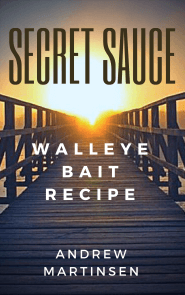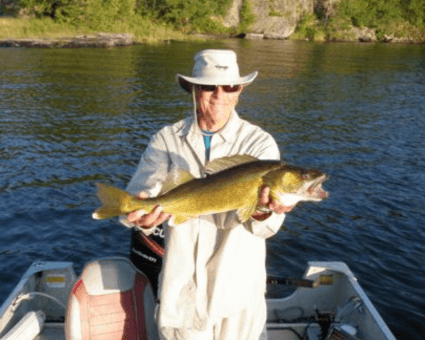Sign up for FREE Walleye Fishing Tips
• Sign up for a Complimentary Copy of
My Report Called "Secret Sauce: The Bait Recipe for More and Bigger Walleyes."

• PLUS, you also get a complimentary subscription to my exclusive email publication, jam-packed with loads of "under-the-radar"
walleye fishing tips that can help you to catch walleyes fast!

Privacy Guarantee: I solemnly pledge never to spam you or sell your email address to anyone, and of course you can unsubscribe at any time.
Contour Trolling
|
Fishfinder Tips
|
Jigging Tips
|
Crankbait Tips
|
Trophy Walleyes
|
More Reports...

Andrew Martinsen's Walleye Fishing Update
Getting a Grasp of the Underwater Landscape
Using a Fish Finder to Find Hot Spots for Walleye
When it comes to waterways, it is easy to forget that they are filled with their own varieties of landscapes. Knowing the bottom of the water you fish will help you get on top of the walleye you want. A fish finder can be an angler's best ally in getting a grasp of the underwater landscape.
Fish finders are handy tools that can capture the look of what lies beneath the water. Obviously, they are useful for finding actual fish. They also can be utilized to capture the scope of the scene beneath the waves.
Devote some time to cruise the water you want to fish. Leave the bait and tackle ashore if the temptation will be too much; this is a reconnaissance trip. The data you collect on this trip can be used all season long when actual fishing occurs.
You will need to take things slow in order to optimize your fish finder's functions. A fish finder can give a fairly accurate lay of the underwater land. It is not as accurate if you are breaking record speeds while using it.
If you haven't read your fish finder's manual, now would be a good time to blow the dust off and crack open the spine. What each projected image represents can vary between models. Make sure you are well versed in your own unit.
In general, straight lines on the fish finder will represent smooth or sandy bottoms. Waving lines represent rocky or gravel bottoms. The height and closeness of the waves indicates the size of the gravel in the beds.
There are many things to look for when cruising the water. Sudden dips or holes are prime spots to hit especially in the warmer months. Walleyes like to suspend in these spots to escape the sun and warm temperatures.
Holes and underwater structures are hot spots that many anglers typically hit. Transition zones are often forgotten or under-utilized areas that can be a walleye gold mine. Once again, the fish finder will be a major player in finding these spots.
Keep a close eye on the fish finder while prowling for prospective fishing transition zones. Holes and dips are easy to spot. Transition zones are more challenging since the change can be more gradual. It is easy to miss a transition area if you aren't paying attention.
Some fish finder units let you mark and save GPS coordinates into them. This is a great way to mark spots that you want to revisit with a pole in hand. If your unit doesn't do this you will have to rely on other techniques.
Physical landmarks are helpful; an accurate lake map is better. You may want to laminate the map once you have added your notations. It would be a shame to loose all that hard work in an unexpected rainstorm.
When it comes to fishing, walleye have the home field advantage. Spending some time on the water with a fish finder can help narrow the gap. Knowing the lay of the underwater land is a great way to narrow your search for those elusive walleye.
You're About to Discover Intense Walleye Fishing Techniques that Can Increase Your Walleye Catch Count When You Hit the Water
Inside My Exclusive Email Publication, You'll Discover...
• An underground Secret Sauce bait recipe for catching walleye.
• Under-the-radar walleye fishing tips that can help you to catch walleyes fast!
• How to create an irresistible attraction to
your offering that can make even satisfied fish that aren't hungry snap at it.
• How to catch more and bigger walleyes using the stuff you've already got in your tackle box.
• And much, much more!

Directions: It's easy. Simply fill in
your name and email address and your first of many FREE
underground walleye
fishing reports will be sent to your email box immediately. Go ahead right now...

"Andrew,

25 Inch Walleye Caught at Lake of the Woods
Walleye Fishing Secrets Student Shares an Awesome Catch

Here's a 25 inch walleye caught at Lake of the Woods, Ontario. The
picture is a great memento for me.
I caught it drifting. We caught it amongst some smaller ones that ended up
on the dinner table.
Your advice was helpful in making my trip successful. Thank you!"
- Russell K.
Join thousands of anglers throughout North America who are catching more and bigger walleyes from shore or on a boat in lakes, rivers and streams:
Join thousands of anglers throughout North America who are catching more and bigger walleyes from shore or on a boat in lakes, rivers and streams:

If you've been wanting to get more satisfaction from your
walleye fishing outings, sign up to my
FREE
walleye fishing catching email publication!
Great Fishin' to You! (Always),
Sincerely,
Andrew Martinsen
WalleyeFishingSecrets.com
WalleyeFishingSecrets.com


